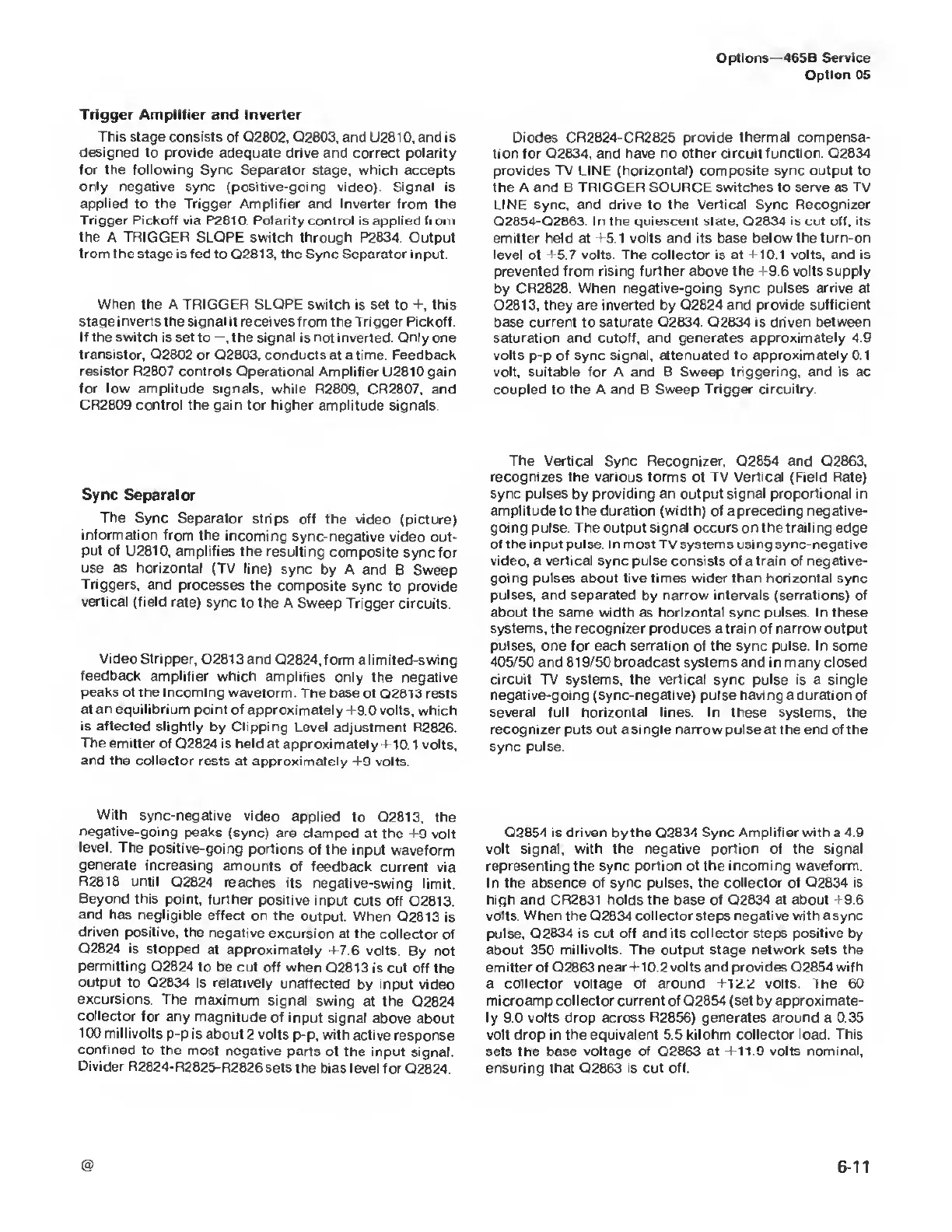Options—465B Service
Option 05
Trigger Amplifier and
Inverter
This
stage consists of Q2802, Q2803, and U2810, and is
designed
to provide adequate drive and correct polarity
for the following Sync Separator stage, which accepts
only negative sync
(positive-going video). Signal is
applied to the Trigger Amplifier
and Inverter from the
Trigger Pickoff via P2810. Polarity control
is
applied from
the A TRIGGER SLOPE switch through P2834
Output
from the
stage
is fed
to Q2813, the Sync Separator input.
When the
A
TRIGGER SLOPE
switch is set to
+,
this
stage
inverts
the signal it receives from the
T
rigger Pickoff.
If the switch is set to -,the signal
is
not inverted. Only
one
transistor, Q2802 or
Q2803, conducts at a time. Feedback
resistor R2807
controls Operational Amplifier U2810gain
for
low
amplitude signals, while R2809, CR2807, and
CR2809 control the
gain for higher amplitude signals
Sync
Separator
The Sync Separator
strips off
the video (picture)
information
from the incoming
sync-negative
video out-
put
of U2810, amplifies
the resulting
composite sync for
use as horizontal
(TV line) sync
by A and
B Sweep
Triggers,
and processes the
composite sync
to provide
vertical
(field rate) sync
to the A Sweep Trigger
circuits.
Video Stripper, Q2813
and Q2824, form a limited-swing
feedback
amplifier which
amplifies only
the negative
peaks of the incoming
waveform The
base of Q2813 rests
at an equilibrium
point of approximately
+9.0 volts, which
is affected slightly
by Clipping Level
adjustment R2826.
The
emitter of
Q2824
is held
at approximately +10.
1 volts,
and
the
collector
rests at approximately +0
volts.
With
sync-negative
video
applied to
Q2813, the
negative-going
peaks (sync)
are clamped
at the +9
volt
level. The
positive-going
portions of the input
waveform
generate
increasing
amounts
of feedback current
via
R2818
until
Q2824 reaches
its negative-swing
limit.
Beyond this point,
further
positive input
cuts off Q2813.
and has negligible
effect
on the
output. When Q2813
is
driven
positive, the negative
excursion
at the collector
of
Q2824 is stopped
at approximately
+7.6 volts.
By not
permitting
Q2824 to be
cut off when
Q2813 is cut off the
output to
Q2834 is relatively
unaffected
by input video
excursions
The maximum
signal
swing at the
Q2824
collector for
any magnitude
of input signal
above about
100 millivolts
p-p
is about
2 volts
p-p,
with
active response
confined
to the
most negative
parts of the
input signal.
Divider
R2824-R2825-R2826
sets the bias
level for Q2824.
Diodes
CR2824-CR2825 provide thermal compensa-
tion for Q2834, and have no other circuit function. Q2834
provides TV LINE (horizontal) composite sync output to
the A
and
B
TRIGGER SOURCE switches to serve as TV
LINE sync, and drive to the Vertical Sync Recognizer
Q2854-Q2863 In the quiescent state, Q2834 is cut off, its
emitter held at L5.1 volts and its base below the turn-on
level of
+5.7
volts. The collector is at
1
10.1
volts,
and is
prevented from rising further above
the +9.6 volts supply
by
CR2828. When negative-going sync pulses arrive
at
Q2813,
they are inverted by Q2824
and
provide
sufficient
base current to saturate Q2834. Q2834 is driven
between
saturation and cutoff, and generates
approximately
4 9
volts
p-p
of
sync signal, attenuated to approximately 0.1
volt,
suitable for
A
and
B
Sweep triggering, and
is
ac
coupled to the A and B Sweep
Trigger circuitry.
The Vertical Sync Recognizer,
Q2854 and Q2863,
recognizes the various forms of TV Vertical (Field Hate)
sync pulses
by providing an output signal proportional in
amplitude to the duration (width) of
a
preceding negative-
going pulse. The output signal occurs on the trailing
edge
of the input pulse. In most TV systems using sync-negative
video, a
vertical
sync
pulse
consists of a
train
of negative-
going pulses about
five
times
wider than
horizontal
sync
pulses, and
separated
by narrow
intervals
(serrations) of
about the
same width as horizontal sync pulses. In
these
systems,
the
recognizer produces a train of narrow output
pulses, one for each serration
of
the sync pulse. In some
405/50 and 819/50 broadcast systems and in
many
closed
circuit TV systems, the vertical sync pulse
is
a single
negative-going
(sync-negative) pulse having a duration of
several
full
horizontal lines. In these systems, the
recognizer puts out
a
single narrow pulse
at
the end of the
sync pulse.
Q2854 is
driven bytheQ2834
Sync
Amplifier with
a
4.9
volt signal, with the negative portion of the signal
representing the sync portion of the incoming waveform
In the absence of
sync pulses,
the
collector of
Q2834 is
high
and
CR2831 holds the base of Q2834 at about +9.6
volts. When the Q2834 collector steps negative with a sync
pulse, Q2834 is cut off and its collector steps positive by
about 350
millivolts. The
output
stage network sets the
emitter of Q2863 near +10.2 volts and provides 02854
with
a
collector voltage of around +12.2 volts. I he 60
microamp collector current of
Q2854
(set
by
approximate-
ly 9.0 volts drop across R2856) generates around a 0.35
volt drop in the equivalent 5.5 kilohm collector load. This
sets the base voltage of Q2863 at
+11.9
volts
nominal,
ensuring that Q2863 is cut off.
